Everyone seemed more keen on standing around and chatting that playing, but eventually, once everyone had arrived, people started dividing up into groups. Ivory began by leading Jade, Sapphire and Cobalt to the other side of the room to play the “Feature Game“, which was the new “hotness” Let’s Go! To Japan. In this game, players are travelers planning, then experiencing their own dream holiday in Japan. Played over thirteen rounds, players draw activity cards place them in different days in their week-long itinerary. These can’t-miss tourist attractions have players traveling between Tokyo and Kyoto as they try to maximize their experience by optimising their activities while balancing resources.
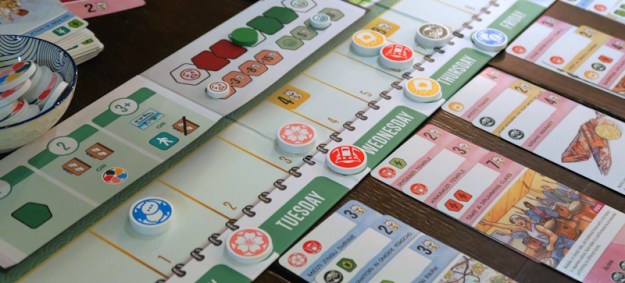 |
| – Image by boardGOATS |
In each of the thirteen rounds, players draw cards according to the pre-organised sequence. For example, there are two decks of cards (Tokyo and Kyoto), and for the first four rounds, players take one card from each deck, keep one and add it to their tableau assigning it to one of the days of their dream, then pass the second card to their neighbour. In the fifth round, players take the four cards they’ve been given and then they place two in their tableau and pass two on, and so on. Once eighteen cards have been played (three on each of the six days), the game is over and players take their planned trip, activating each of their cards in order, starting on Monday and work their way through to Saturday.
 |
| – Image by boardGOATS |
There is a catch: where there is a swap between the two decks, players have to move between the cities of Tokyo and Kyoto by playing a Luxury Train Ticket which they can acquire during the game. Each of these is worth two points. If players do not have enough tokens to cover each change, they play a Regular Train Ticket from the supply which costs them two points. Activating cards involves moving the players’ five Experience tokens along a track, increasing or decreasing their Mood, Stress and Happiness, gaining points and then evaluating the requirements for the Highlight of the Day depicted on the final card of the day. If these requirements have been fulfilled, the player gets bonus points and the player with the most points at the end of the game is the winner.
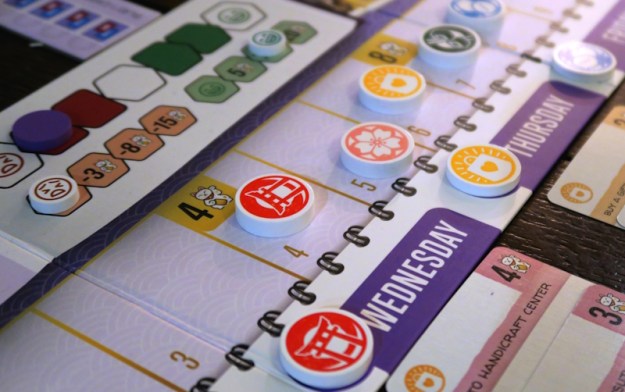 |
| – Image by boardGOATS |
The game rattled along very quickly with swift turns and the added bonus that setup was quite rapid too. As a result, it was easily under forty-five minutes before everyone was explaining their plan and scoring it. That said it was hard to keep track of what everyone was doing. Ivory was the first to fill a day and managed to get everything aligned to get the top bonus of a Luxury Train ticket. Although this was very nice, it in no way indicated Ivory was going to get a big score. Jade and Cobalt quickly followed suit, Cobalt also gaining Luxury Train Tickets (which he got quite a few of throughout the game), and Jade got quite a lot of the second best reward, choosing Wild Tokens that would be really useful at the end of game to ensure meeting Highlight of the Day/End of Game objectives.
 |
| – Image by boardGOATS |
Sapphire was spreading his activities out a little bit more, but as the game went on he also managed to build a large store of wild tokens. At the start of the game, Jade and Sapphire (who were not sitting next to each other) focused more on Kyoto, whereas Ivory and Cobalt were playing a lot more Tokyo cards. Inevitably, however, everyone ended up going to both cities and need Train Tickets as a result. Cobalt and Jade were the only people who choose to grab research tokens; Cobalt used one of these mid-game and managed to manipulate his hand so he ensured he passed nothing of use to Jade, much to his annoyance. Otherwise, everyone worked on their mental health and managed to keep their stress down scoring positive points for the trip.
 |
| – Image by boardGOATS |
At the end of the game, Sapphire, Jade and Ivory had minimized their travel between the two cities though, whereas Cobalt required a lot of trains: as he had lots of Luxury Train Tickets he actually increased his score significantly with these. Jade had not picked up enough Luxury Train Tickets, so was stuck on commuter trains causing him to lose a lot of points. Sapphire ended up with a quick return trip between Kyoto and Tokyo on his last day, but that was acceptable because you should always go out your way for Sake!
 |
| – Image by boardGOATS |
Scoring took longer than usual as everyone gave a detailed description of their trip. Both Cobalt and Sapphire scored well on every day of their trip, with Cobalt slightly ahead thanks to his Luxury Train Tickets. Sapphire managed to complete all his Highlight of the Day objectives though without using his wild tokens, so he cashed these in at the end of the game to push all his tokens into the next scoring zone and subsequently won the game by two points from Cobalt. It had been a highly enjoyable experience though, enhanced by the beautiful components, especially the extremely pretty, but totally over the top ceramic component bowls!
 |
| – Image by boardGOATS |
From there, the group then played a game of Faraway, a light game set on the mysterious continent of Alula with its ever-changing geography, shaped after the rhythm of the seasons. On each turn, players play a card from a hand of three. As play is simultaneous, players must take into account the priority system in all their choices—being last to pick a card leaves fewer options and often less profitable choices for later turns. During the game, players will play a row of eight cards in front of them, from left to right. These cards represent the regions they will come across while exploring the lands. Characters on these cards will give victory points if the player later fulfills the conditions they demand. At the end of the game, players walk back along the same route, scoring cards in the opposite order to that they were played in—and therein lies the heart of the game-play.
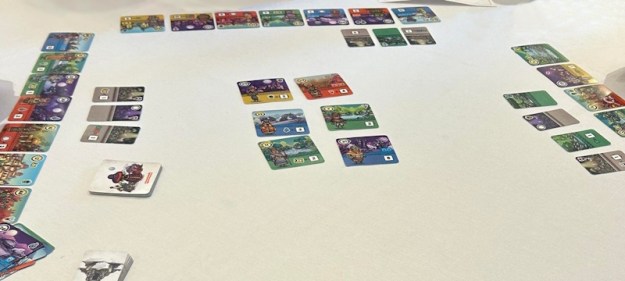 |
| – Image by boardGOATS |
Throughout the game, the cards played serve both to set new objectives, and to meet ones played previously. This time, Ivory started quickly out of the traps playing the highest card and subsequently getting the last pick in the following round, which was a minor hindrance. As the game went on, the order of picking the cards changed each time and everyone managed to pick first at some point, although it did seem like Sapphire and Ivory had the greatest varieties, mostly either being first or last! Jade was very quick off the mark getting lots of maps which gave him a significant card advantage throughout the game as he could look at four or five cards and pick the best one. Ivory also didn’t do too badly with maps.
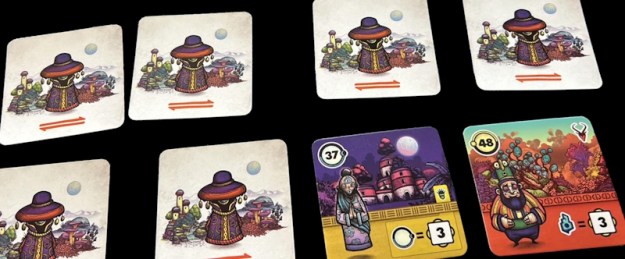 |
| – Image by boardGOATS |
It eventually became clear that Jade had managed to play his cards in such a way he was always playing a higher card than his last card giving him an additional secondary card, but he was also able to fulfill the requirements to score the objective on that card even though it would need fulfilling earlier in the journey. Come the end of game scoring and going on their journey, both Cobalt and Ivory had slightly take their eye of the ball and missed fulfilling the requirements of some of their cards and thus missed out on points they though we were going to get. In the end, it was very close for second place Sapphire just taking it, while everyone was thrashed by Jade.
 |
| – Image by boardGOATS |
On the next table, Green was keen to play Lost Ruins of Arnak, and was eventually joined by Black and Plum. This game combines deck-building and worker placement with resource management. Players start with six cards in their deck, two Money, two Compasses and two Fear cards, and draw five of these to play. As in the original deck-builder, Dominion, or in the racing games, Flamme Rouge and Snow Tails, Fear cards clog up players’ decks and more are acquired as the game progresses. But also as in Dominion, there are ways to “exile” cards during the game. So, players can try to keep a tight deck with minimal cards, or try to buy lots of cards that work well together.
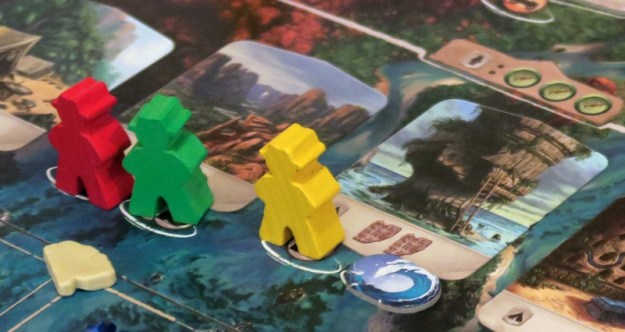 |
| – Image by boardGOATS |
Players then have two meeples each that can be sent to locations on the map, to either discover or use an action Location. These generally give Resources plus some additions like draw a card, or gain a Fear card etc.. Each new site also has a Creature guarding it, which, if beaten, will give points and a small one-time bonus. The Research Track is where players spend three of the resources, Tablets, Arrows and Jewels. Each player has two tokens which move up the same track giving different rewards as it ascends. Thematically, you can’t write stuff in the notebook until you find it with your magnifying glass, so the former can never overtake the latter on the track. And of course, the notebook gives cooler rewards.
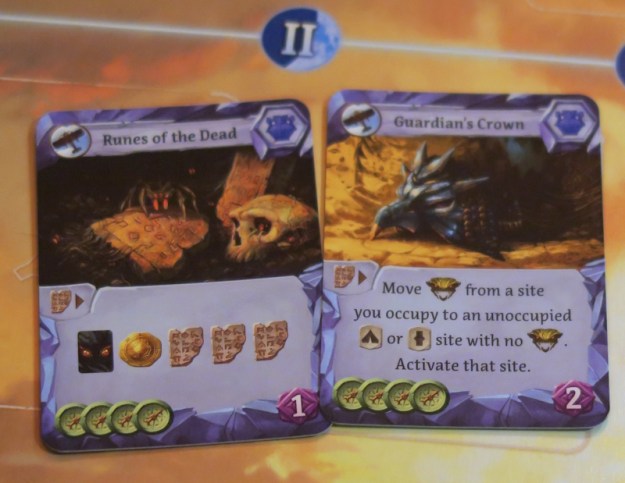 |
| – Image by boardGOATS |
Players get one action each per turn, until everyone has passed signalling the end of the round, and the game finishes after five rounds. At the end of the game, Points are awarded for Cards, for progress on the Research Track, for discovering Locations and for beating Creatures; the player with the most points at the end is the winner. This time, early in the game, Green pointed out to Plum that she could use an Idol gained by defeating a Guardian to give her the resources she needed to go up the Research Track. That gave Plum an Assistant and she picked one that turned a Boot into an Arrowhead.
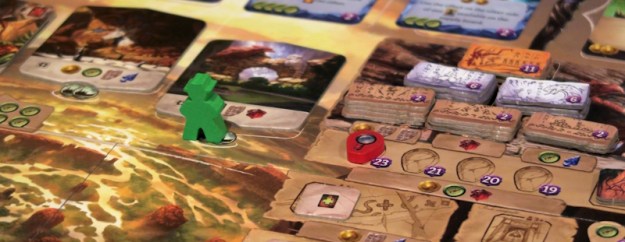 |
| – Image by boardGOATS |
Green bought the card Plum had been eying up, which let players rid themselves of Fear cards (worth minus one point), and therefore seemed like a good use for a Boot/Fear. It was pointed out later, however, that any card could be used in place of the Boot as all other transport types work for Boot icons. Plum then got an Assistant that could upgrade a resource, which in practice she used turn Arrowheads into a Rubies as that was all she had by the end of the rounds. She also managed to get ahead with her Explore magnifying glass token and was the first to a new level on a couple of occasions, which gave her valuable bonuses.
 |
| – Image by boardGOATS |
Green picked up a couple of Fear cards from leaving Guardians undefeated; Black got at least one as well, but Plum managed to dodge them. Both Black and Green got useful Artifact Cards where they could get lots of resources. It was a little way in that the group noticed the slight Rules Malfunction: although players were putting their new cards at the bottom of their Draw pile, players were then shuffling the Draw and Discard piles together before drawing new cards. This gave an extra bit of randomness that this time, worked in Plum’s favour. For example, she had an item card that gave a Compass per worker when it was played, and it seemed to put in a lot of appearances. In contrast, all the cards Green had bought didn’t come out until the final round—he got the balance of the bad luck.
 |
| – Image by boardGOATS |
Black picked up an Assistant which helped him cycle through his cards which helped mitigate the randomness a little, though there were a couple of occasions when someone took the location he had been working towards. Right at the end of the game, when Plum had managed to reach the top of the Explore/Research Track with her magnifying glass, she was able to use the Icons on her board to get the resources needed to pick up one of the most valuable Temple Tiles—worth eleven points. Green, however, scored almost twice that of the others for his Idols and Black top-scored for his item and artifact cards.
 |
| – Image by boardGOATS |
It was the Temple points, together with the extra points Plum got for getting to the top of the Explore/Research Track that ultimately made the difference, giving her a total of sixty-nine points, thirteen more than Green who took second place. Both Plum and Green had played before, though most of their previous games had been online where the administration of the card shuffling was done for them, hence the Rules Malfunction. It was Black’s first game, and despite the rules issue and not scoring as well as the other two, he still really enjoyed the game, so there is a good chance it will get another outing in the not too distant future.
 |
| – Image by boardGOATS |
Meanwhile, that left six players; Pink was keen to give his favourite panda game another outing, so Pine and Lime joined him in a game of Zoo Break. This is a cooperative game, where players work together to try to prevent animals escaping from Bedlam Zoo. On their turn, players roll the die to decide how many Action Points they get, then, after carrying out their turn, flip a Escape Card and a then a Move Card to determine what gets out of its cage and what moves. Players have to avoid getting trampled on or bitten by the animals, while catching them and then locking them in their cages.
 |
| – Image by boardGOATS |
The group started well, or at least it started well from Pink’s perspective when he was cuddled by a Panda (one of his real-life wishes). However, the game did not go so well. There are a number of optional variants, and the group had chosen to use the “Faulty Lock” Variant which means that if an escape card is drawn for animals who have already been locked up, the die is rolled to determine whether there are escapees. This turned out to make things just a bit too difficult and a Coral snake quickly made a bid for freedom, and as it’s a dangerous animal, that was that. One snake might not seem like much, but there were another five lining up in front of the gate and three tigers too, so it really did not go well.
 |
| – Image by boardGOATS |
Reluctant to leave it like that, the trio decided to give it another try, this time without the “Faulty Lock” Variant. This second try went better, though at one point two elephants got very close to the exit. The situation was rescued by peanuts which enticed them to the Snack Stall where they were eventually captured. There was some extensive rules reading to decide whether Pandas were considered “Dangerous” so only one escaping would trigger failure. The group concluded that Pandas were not Dangerous animals after all though, and four Pandas roaming the streets would not lead to closure of the Zoo (though perhaps the Chinese government would not be appreciative).
 |
| – Image by boardGOATS |
In the end, the distinction wasn’t necessary, none of the Pandas got out, though one Capuchin did manage to escape. That was all, however, and once the group finally rounded up the last of the mad Meercat escapees, the writing was on the wall and the Zoo was saved. The other games were still underway, so once the charming wooden animals had been tucked away, the trio opted for a couple of rounds of Coloretto. This is a charming little card game which is the core of the, arguably better known board game, Zooloretto.
 |
| – Image by boardGOATS |
The game is very simple: Players either draw a Chameleon card from the deck and add it to one of the Carts, or take the cards on one of the Carts and add them to their tableau, stepping out until everyone else has taken a Cart. Each Cart has three spaces and players core points for their three largest sets of cards and negative points for any others. The player with the most points at the end of the round after the trigger card is revealed is the winner. The clever part is the scoring for sets, which uses the Triangular Number sequence and means that later cards are worth a lot more than the early ones.
 |
| – Image by boardGOATS |
When the Golden Chameleon card came out, there was some discussion about the difference between it and the multi-coloured Chameleon. Blue, on the next table was consulted, and explained that it meant the person who takes it gets an extra card drawn from the top of the deck. With that sorted, the game continued. The group played two games and both were close, especially between Pine and Pink with Pink just edging it for the first game by two points and Pine just beating Pink by a single point in the second. Both games were won by Lime, however, and by a larger margin, taking the first by four points and the second by six.
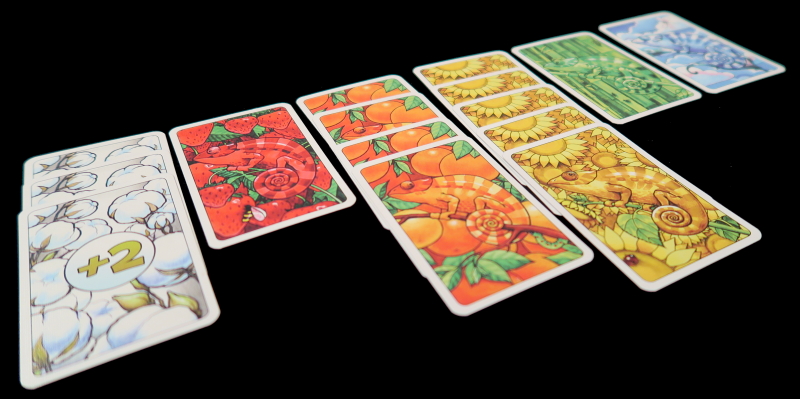 |
| – Image by boardGOATS |
The last table included three players, Blue, Purple and Byzantium. They were the last to start, and were somewhat torn between two of the current hot games in the group, Wyrmspan and Meadow. After some discussion, the group went for what was probably the easier of the two, and gave Meadow its their outing in three consecutive meetings. A light to medium card collection game, it was new to both Purple and Byzantium, so Blue explained the rules. Most of the game is built round a Card Market with players placing an Action Token and taking a card into their hand, before playing a card from their hand.
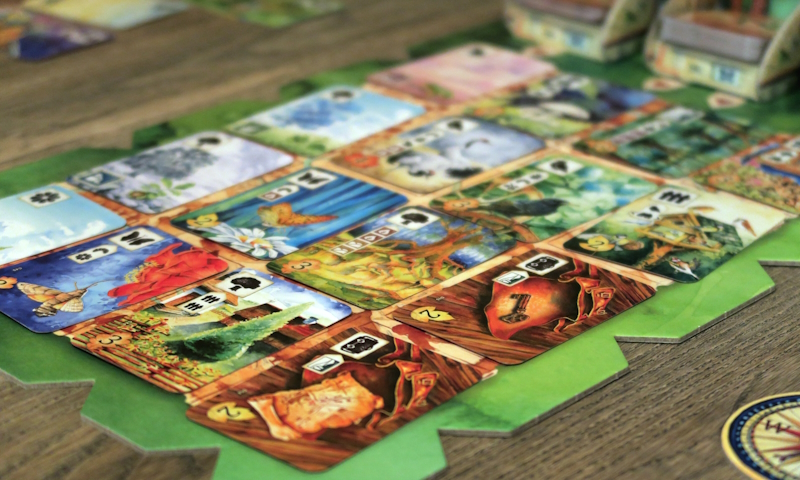 |
| – Image by boardGOATS |
This aspect of the game has led to some reviewers comparing the game to Splendor, though there is a lot more to the game than that. In addition to the Market, there is a second Campfire board, which allows players to carry out special actions, and also claim Bonus points. for cards in their tableau. The first time the game was played, there was a token included erroneously from the Envelope U mini-expansion, and last time the game got an outing, there was a minor rules malfunction where the four players ended up playing on the three-player board. So although the game has been played three times in fairly quick succession, this time was the first time the game was played by the rules as written, probably.
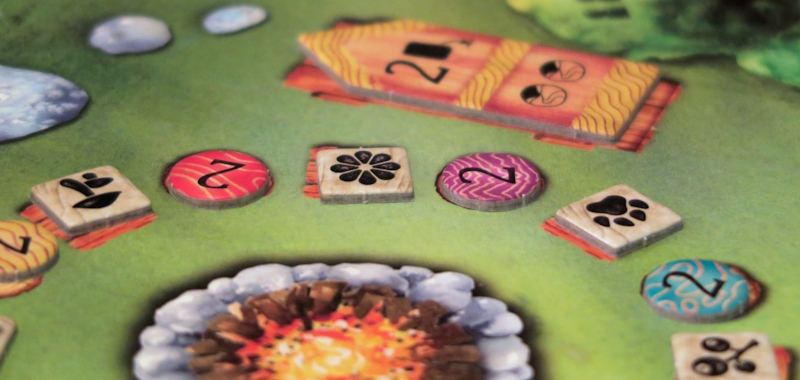 |
| – Image by boardGOATS |
Players start with a hand of cards, including one from the North deck (which is only introduced halfway through the game)—this last card is typically more worth more but is difficult to play, so is a good way to get a steer in the early stages of the game. As well as the other cards in their starting hand, another key strategy lead is the Bonus points obtained from the Campfire board. These are obtained by placing a Bonus point token between two Icons, but in order to do so, the player must have those icons in their tableau. Since each bonus place can only be claimed once, this element of the game is something of a race between those who want to compete for these points.
 |
| – Image by boardGOATS |
This time, the Icons drawn at random and placed round the Campfire included the relatively scarce Cottage, Fence and Garden Bird as well as the Wolf and Hawk which only come out in the second half of the game, when the North deck is introduced. This made the Bonus points hard to claim. Although neither Blue nor Byzantium appreciated it at the time, although most Wolf cards are in the North deck, this copy of the game included the Seal promo card, which is a Wolf card that hides in the South Deck. As it was key to getting bonus points, when it came out, both Blue and Byzantium spotted it, but Blue got to it first, and that turned out to be critical to her Bonus point objectives as Byzantium pinched the other spots early.
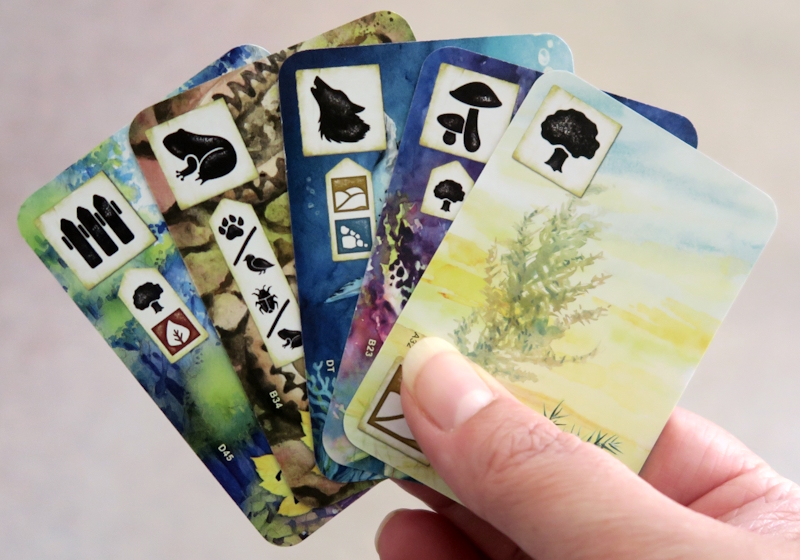 |
| – Image by boardGOATS |
Meanwhile, Purple was busy collecting frogs and very effectively daisy-chaining cards to give her points. As the game moved into its final rounds, Byzantium struggled to get a Landscape card that he could play without needing too many difficult prerequisites. In spite of the frustrations when players can’t get cards, the game has a nice gentle roll to it and with three players doesn’t outstay its welcome in the way it does with four (when there are two extra rounds). It was quite a tight game—Purple and Byzanium finished with thirty-seven and thirty-six points respectively from their observations, but Byzantium had more points from his Landscape cards.
 |
| – Image by boardGOATS |
Blue didn’t do as well as them with her observations, but had the most points from her Landscape cards. Although Purple hadn’t managed to get any Bonus points, both Blue and Byzantium had picked up the full nine giving them a bit of a lead. In the end, it was the Observations that were key, and they gave Byzantium victory by four points with a total of sixty. As the Meadows were tidied up, the last of the other games came to a close too and everyone chatted until it was time to go home.
 |
| – Image by boardGOATS |
Learning Outcome: Every game should come with ceramic component bowls.